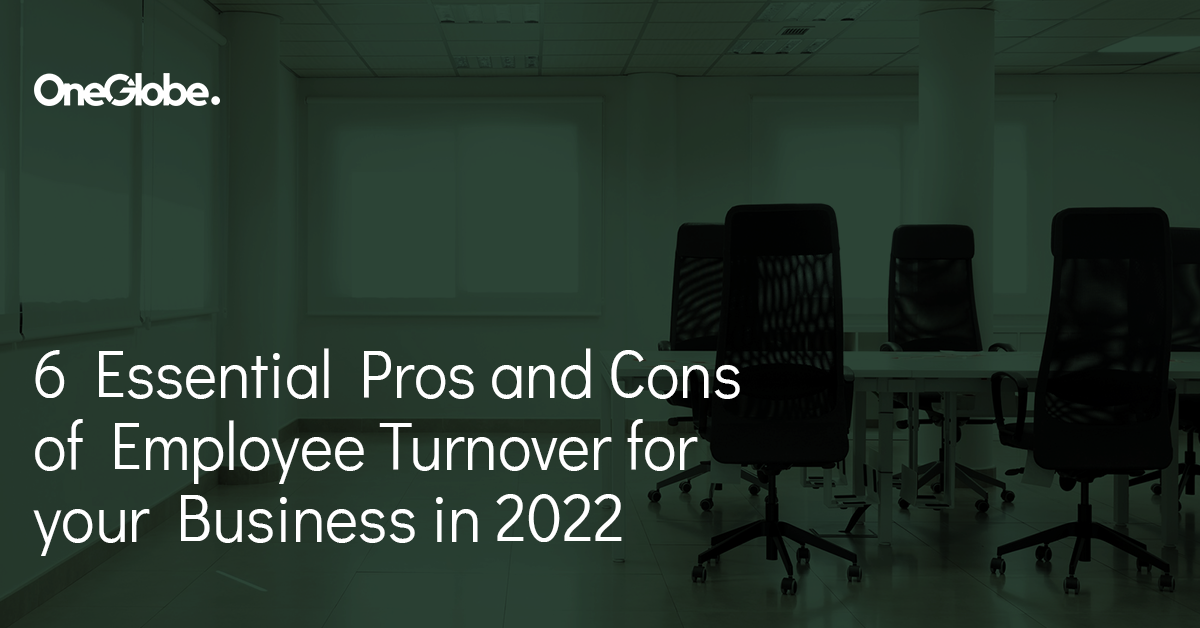
Whether you’re a small-scale business or a large-scale international enterprise, employee turnover is a scary prospect for many CEOs and recruiters. Employees leaving the company for any reason pose a challenge for the employer to fill their vacancy quickly and effectively.
According to HubSpot, the average turnover rate in 2021 across various industries was 57,3%. Projections for 2022 indicate that 40% of the workforce worldwide will leave their employers for one reason or another, adding to their company’s employee turnover rate. Let’s discuss the pros and cons of turnover and how you can manage your job listings with Jobs OneGlobe to fill your vacancies properly.
Employee Turnover – What is it Exactly?
Let’s cover the basics of employee turnover before we move on to the pros and cons of embracing it in your company. According to Cambridge Dictionary, employee turnover is “the rate at which employees leave a company and are replaced by new employees”. In practice, this represents the process of employees leaving your company (being fired, handing in their resignation, etc.), and you then hiring new staff to replace them.
For example, if you have 20 employees and two of them leave, only for you to hire new talent after, your employee turnover rate is 10% – meaning, 10% of your staff was “turned over”, or replaced. Whether turnover is good or not for a company is up for debate, and many HR professionals have struggled to give a concrete answer to this question.
Based on statistical findings, an average company will go through an 18% employee turnover in its staff yearly. Up to 6% of staff can leave a business based on poor performance or other terminations over employer-employee disagreements yearly. The fact of the matter is that employee turnover is a corporate reality, and employers need to address the need to hire new staff within their companies quickly. Here’s why turnover is good, and why it can harm your company so that you can make a more informed decision on how to proceed with your staff recruitment.
“Turnover can be one of the most expensive problems at a company.” – Shawn Achor
The Pros and Cons of Employee Turnover for your Company
Pro #1: Ability to Hire Fresh Talent
The first reason why turnover may be positive for your company is that it will enable you to reshuffle your staff and hire new talent. By losing some talent today, you’ll be able to hire new professionals with a fresh perspective on your business model.
This can rejuvenate your company and add some diversity to your staff which may have stagnated over the years. By hiring young professionals, for example, you’ll gain access to skill sets that are currently trending and easy to apply to modern projects. Or, by hiring seasoned industry veterans, you’ll help existing staff get better at their jobs with the help of the new hires.
Pro #2: Lose Underperforming Staff
Unfortunately, some of your staff members will underperform and cause entire teams or departments to stagnate. If this happens, you’ll have to make the hard decision to let go of some of the underperforming members of your staff. In doing so, you’ll be able to hire new people who will be more productive and add to your staff’s motivation.
Letting people go is never easy, no matter how high you may be up the ladder in your company. Find objective reasons and compassionate ways to announce these types of news to your employees – there’s no need to be cruel about it. However, if certain members of your staff are underperforming, employee turnover may be the best solution for everyone involved.

Pro #3: Improvements for Morale and Culture
When your staff stagnates in performance, there are usually good reasons for that. Employee turnover can help you reinvigorate your staff and help them get back on track in more ways than one. The staff you hire will add to the existing employees’ morale and kick-start their productivity.
Onboarding new people into your company can help improve your company culture and breathe new life into it. This will help bring new concepts, insight, and knowledge to your staff which would otherwise be impossible to do. In turn, your business culture will become more proactive, team-oriented, and focused on growth and evolution rather than stagnation and outdated industry practices.
“Managers tend to blame their turnover problems on everything under the sun while ignoring the crux of the matter: people don’t leave jobs; they leave managers.” – Travis Bradberry
Con #1: Recruitment Cycles Can Get Long
One of the reasons most employers fear turnover is because it can lead to prolonged recruitment cycles. Hiring new employees inherently takes time and resources, and you’ll need to hire the right people, not just anyone. While recruitment can extend into several weeks or months, it’s not as bad as most would lead you to believe.
There are various ways for you to manage your recruitment cycle and find the right people more quickly. You can use Jobs OneGlobe for example to promote your job listings or company with specialized promotional packages. These packages will fast-track your job listings and ensure that more people see them, thus leading to a better talent pool for you to work with.
Con #2: Risk Lowering your Brand Reputation
As your employee turnover rises, your brand reputation may take a hit. Many job seekers go out of their way to research a company before submitting their applications. They may find out that many of your employees have left the company for some reason but have no other info to go on. This can cause issues for you when trying to hire new staff with may be reluctant to apply for your jobs.
You can mitigate this by relying on review aggregate websites and responding to ex-employee reviews as objectively as possible. Don’t throw or assign blame on anyone and be as diplomatic and professional as possible. Your brand reputation is one of the most valuable tools in your marketing arsenal. When employee turnover happens, do your best to keep track of it and make sure that no future employees are dissuaded from applying for your jobs.
Con #3: Difficulties in Filling Leadership Positions
Employee turnover means that many of your staff likely won’t stay employed for more than several years. This can cause issues for your company in regards to natural leadership progression and employee advancement. By letting employees go, you’ll effectively have to train new staff from the ground up and start from the proverbial scratch.
While new staff may be just as competent as your previous employees, they won’t be as familiar with your business model or company culture. This means that you may run into issues promoting them into managers or assigning leadership roles to them without some extra onboarding. Existing employees may also run into problems accepting new managers who have proverbially cut the line and become managers overnight. It’s a difficult thing to nail down, so you should handle your employee turnover with care toward existing staff, as well as anyone you hire afterward.
“An employee’s motivation is a direct result of the sum of interactions with his or her manager.” – Bob Nelson
Hire New Employees with Jobs OneGlobe
At the end of the day, employee turnover isn’t something you can affect directly. People will leave your company for a variety of personal and professional reasons, many of them being unique to the individual. Someone might want to move abroad, have family obligations, or want to seek better-paying jobs and simply leave. When that happens, you’ll need to start recruiting new staff to fill the newly vacant positions.
Jobs OneGlobe can help you create job listings and promote them so that the right types of candidates apply for them. All you need to do is collect the information relevant to your job listing, outline some employment incentives, and publish your listing. Make the best out of employee turnover and your company and its business culture won’t suffer from the turnover.




Share
Facebook
Twitter
LinkedIn
Telegram
Tumblr
WhatsApp
VK
Mail